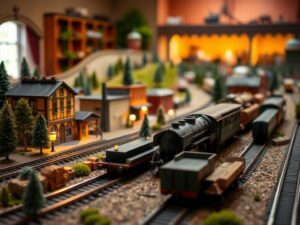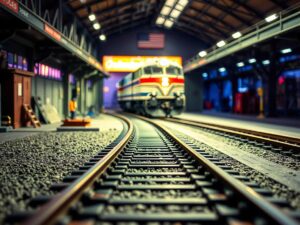How to Choose the Right Power Supply for HO Scale Trains
How to Choose the Right Power Supply for HO Scale Trains
How to Choose the Right Power Supply for HO Scale Trains
Welcome aboard, fellow rail fans! Today, we’re diving deep into a crucial component of any HO scale model railroad: the power supply. Just like real trains need electricity to chug along the tracks, our miniature marvels require a reliable source of power to bring their engines to life and keep those wheels turning.
Choosing the right HO scale power supply can seem daunting at first, but fear not! With a little guidance and understanding, you’ll be well on your way to powering up your railway dreams with confidence.
Let’s Start with the Basics: What is an HO Scale Power Supply?
Think of it as the heart of your model railroad. This specialized electrical device provides the juice needed to run your HO scale trains (trains with a 1:87 scale ratio) on your meticulously crafted layouts.
There are several types of power supplies commonly used in HO scale model railroads:
- DC Power Packs: These traditional power sources offer adjustable voltage, allowing you to fine-tune the speed and performance of your trains. They typically have a forward/reverse switch and sometimes additional features like a throttle control knob for precise speed adjustment.
- AC (Alternating Current) Transformers: These are primarily used in older layouts but can be found with some model railroading suppliers. AC power delivers electrical current that changes direction rapidly, creating a more pulsating power flow. Some AC transformers offer variable voltage output, similar to DC power packs.
-
Digital Command Systems (DCC): For advanced model railroaders seeking sophisticated control and features, DCC systems reign supreme. They allow you to individually control each train on your layout, adjust its speed and direction precisely, apply lighting effects, and even simulate real-world railroad sounds and announcements!
Key Factors to Consider When Choosing an HO Scale Power Supply:
Now that we understand the types available, let’s delve into the factors influencing your decision:
1. Voltage Requirement: HO scale trains typically run on DC power between 12 and 18 volts. Your power supply needs to provide a suitable voltage range for your engines. Check your train engine’s specifications or packaging to confirm the recommended operating voltage.
2. Amperage Capacity (Current): Measured in amps, this refers to the maximum amount of current the power supply can deliver. It’s crucial because powering multiple trains simultaneously demands more amperage than running a single engine. Consider the number of trains you plan to run concurrently and consult the motor requirements of your engines for their amperage needs. Generally speaking, aim for at least twice the total amperage requirement of your heaviest locomotive draw when choosing an HO scale power supply.
3. Adjustable Voltage Control:
Being able to adjust voltage is a fantastic feature for fine-tuning train speeds and realism.
* Dial Controllers: These classic knobs allow for gradual voltage adjustments.
* Digital Throttle Controls (DCC): With DCC systems, you can set precise voltage levels for individual trains using handheld throttles.
4. Output Current Ratings and Reverse Functionality: Make sure your power supply has adequate output current to handle the draw of all the trains running simultaneously on your layout. Also, ensure it offers reverse functionality so you can control train movement in both directions.
5. Additional Features (Optional but Delightful!): Some HO scale power supplies come equipped with extras that elevate your modeling experience:
* Speed Controller: These often allow for smoother transitions between speed settings.
* Programming Capability: Certain DCC systems offer programming functions to personalize train sounds, lighting effects, and even individual train IDs.
Power Supply Types Explained:
Let’s break down the power supply options a bit more:
DC Power Packs:
- Ideal for smaller layouts or beginner hobbyists.
- Affordable and easy to use.
-
Offer variable voltage control for adjusting train speeds.
- Typically feature a forward/reverse switch and a single speed control knob.
AC Transformers:
- Generally used with older model railroad setups but can be found online.
- Can be cost-effective for powering many small electric items, including DCC systems.
- AC power’s pulsating nature might require additional components for smoother train operation in some layouts.
Digital Command Systems (DCC):
- Offer the ultimate control and realism in model railroading.
- Individual control over each locomotive on your layout, adjusting speed, direction, lights, sound effects, etc.
- Requires an initial investment but provides incredible versatility for experienced hobbyists.
Tips for HO Scale Power Supply Success:
-
Start Simple: If you’re a newcomer to model railroading, a basic DC power pack will serve you well as you get acquainted with the fundamentals.
-
Gauge Your Power Needs:
Assess how many trains you plan to run simultaneously and their amperage requirements before choosing your power supply.- Think About Expansion: Itâs often a good idea to select a power supply that has room for future growth if you anticipate expanding your layout or acquiring additional trains.
-
Read the Manual!: Sounds basic, but each HO scale power supply model comes with instructions specific to its features and usage. Make sure you understand all functions before plugging in your first train!
-
Stay Safe: Electricity can be dangerous. Always disconnect your power supply when not in use and ensure that your wiring is secure and insulated properly.
Remember, choosing the right HO scale power supply is an investment in the enjoyment and longevity of your model railroading journey. Take your time, do your research, and donât hesitate to ask experienced hobbyists for advice along the way!




